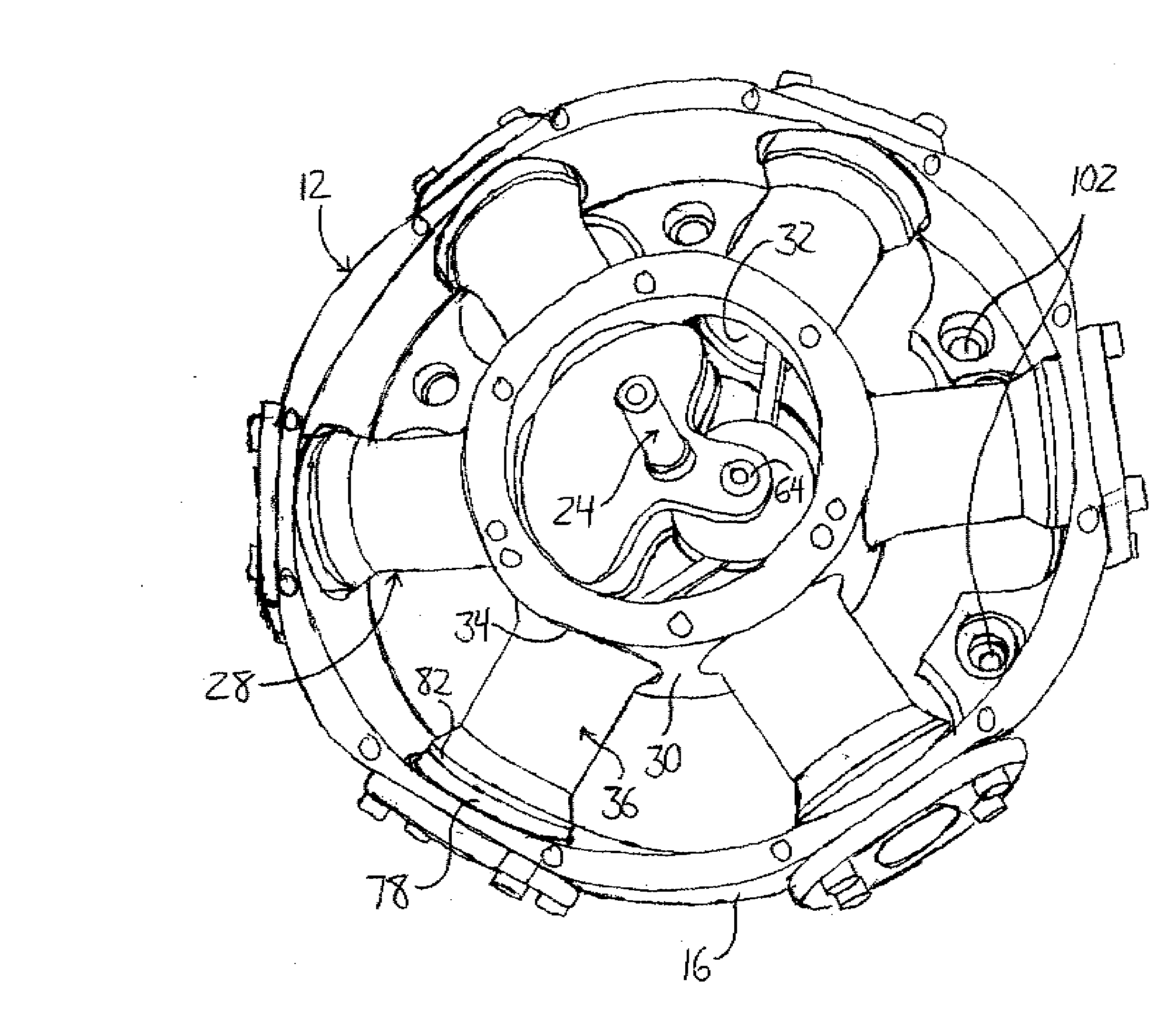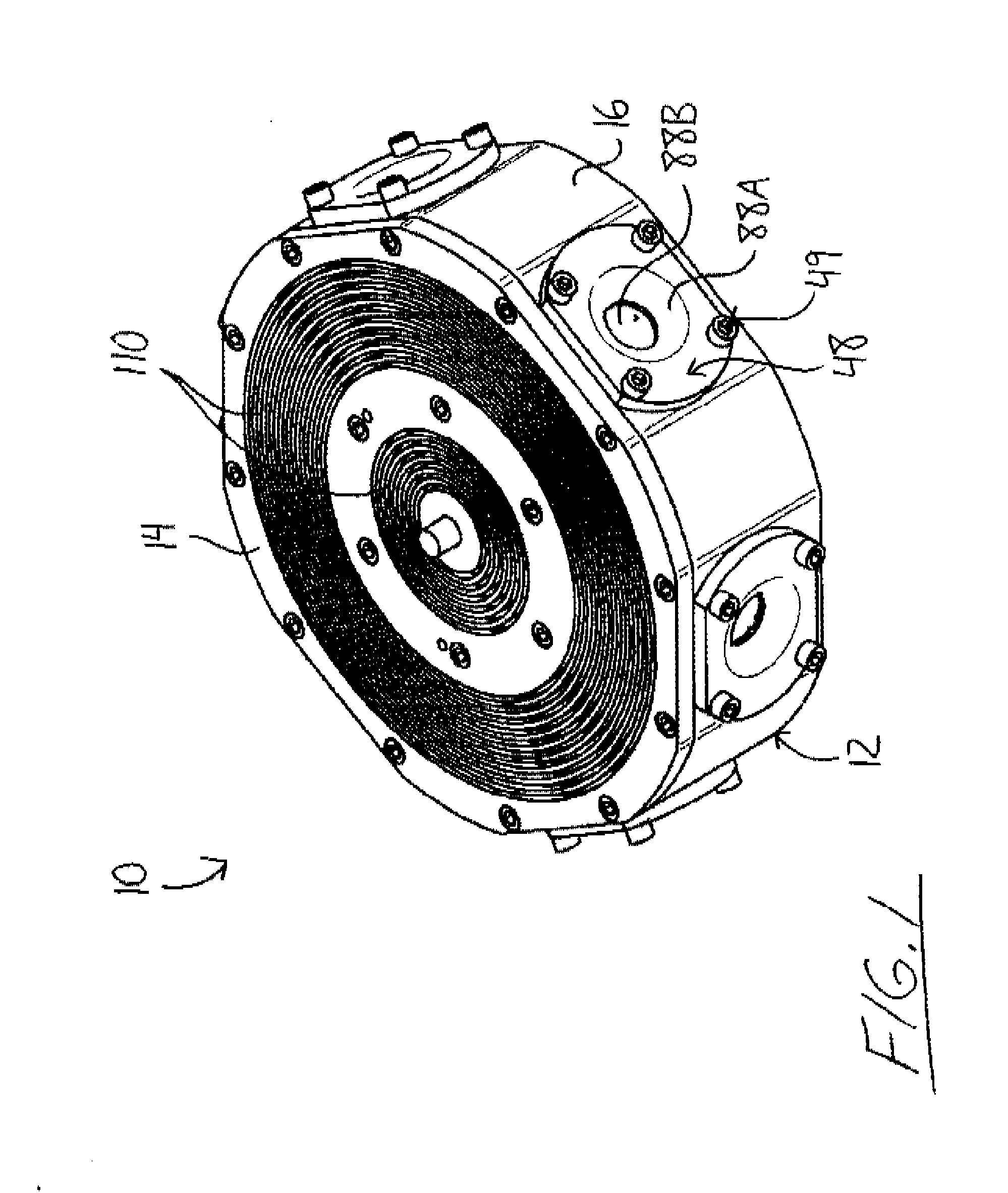Reciprocating compressor or pump and a portable tool powering system including a reciprocating compressor
a reciprocating compressor and compressor technology, applied in the direction of conductors, flexible pipes, couplings, etc., can solve the problems of pin premature failure when significantly reduced in scale, pneumatic tools requiring a steady source of compressed air for operation, and the mobility of conventional air compressors is often limited
- Summary
- Abstract
- Description
- Claims
- Application Information
AI Technical Summary
Benefits of technology
Problems solved by technology
Method used
Image
Examples
first embodiment
[0186] The housing 12 features an interior annular cylindrical wall 30 disposed concentrically within the exterior wall 16. Annular spacing between the two walls forms a receiving compartment in which the gas compressors 28 are disposed, extending radially between the two annular walls. In the first embodiment, the plurality of gas compressors includes six compressors arranged in diametrically opposed pairs and evenly spaced about the central axis of the housing 12. The space within the interior wall 30 defines a crankshaft compartment for housing components of the compressor's drive system. The interior wall 30 features round through-holes 32 each of which receives a drive end 34 of a cylinder liner 36 of a respective gas compressor 28, A valve end 38 of the cylinder liner 36 opposite the drive end 34 is received in a through-hole 40 provided in the exterior wall 16 axially aligned with the respective though-hole 32 in the interior wall 30.
[0187]FIG. 5 shows one of the gas compress...
second embodiment
[0219] As shown in FIGS. 10 and 11 the second embodiment compressor 200 does not feature a unitary housing, but instead includes two separate housings. A receiver housing 202 defines a manifold into which compressed gas is exhausted from the cylinder liners 36 and is formed by a bottom half 203 and a top half 204 which mate together with the cylinder liners 36 disposed between them. With its halves mated together, the receiver housing 202 is annular in shape so as to define a central opening 206. A crank housing 208 is positioned within the central opening 206 of the receiver housing 202 and similarly has an annular shape defining a central opening, within which the body of the master connecting rod 52 and the crank pin are disposed. The cylinder liners 36 are received in openings 210 extending radially through the annular crank housing 208 from the central opening thereof toward the surrounding receiver housing 202. The cylinder liners 36 are sealed to the crank housing 208 at thes...
third embodiment
[0244] A base 302 of the third embodiment compressor 300 supports three gas compressors 28 equally spaced about and extending radially relative to a central axis of the base 302. The base 302 is a block of solid material having two identical, flat, parallel opposing faces 304, 306 with a periphery defining a constant thickness of the body 302 perpendicular to the opposing faces 304, 306 that is significantly less than the span of the identical faces 304, 306. The periphery of the body 302 is shaped such that the body has the appearance of having been formed from an irregular hexagonal body with three long sides of identical length and three shorter sides of identical length, the short and long sides alternating along the periphery of the hexagonal body, which has had the long sides each equally recessed toward the center of the body along the opposed faces 304, 306. Looking at the plan view of FIG. 24A, each resulting recessed longer side 308 of the body 302 is made up of three line...
PUM
 Login to View More
Login to View More Abstract
Description
Claims
Application Information
 Login to View More
Login to View More - R&D
- Intellectual Property
- Life Sciences
- Materials
- Tech Scout
- Unparalleled Data Quality
- Higher Quality Content
- 60% Fewer Hallucinations
Browse by: Latest US Patents, China's latest patents, Technical Efficacy Thesaurus, Application Domain, Technology Topic, Popular Technical Reports.
© 2025 PatSnap. All rights reserved.Legal|Privacy policy|Modern Slavery Act Transparency Statement|Sitemap|About US| Contact US: help@patsnap.com



